An email disclaimer protects your business from data leaks, legal risks, and compliance issues. This guide explains what to include, when to use one, and how to write clear, professional disclaimers that actually work.
Contents:
- What Is an Email Disclaimer?
- Do Email Disclaimers Have Legal Value?
- When Do You Need an Email Disclaimer?
- Key Elements of an Effective Email Disclaimer
- Email Disclaimer Examples and Templates
- How to Add a Disclaimer to an Email
- FAQs About Email Disclaimers
What Is an Email Disclaimer?
An email disclaimer is a short notice added to the end of an email that outlines the sender’s legal responsibilities and protects the organization against potential risks.
It usually appears just below the email signature, often in smaller text, but its purpose is far from minor.
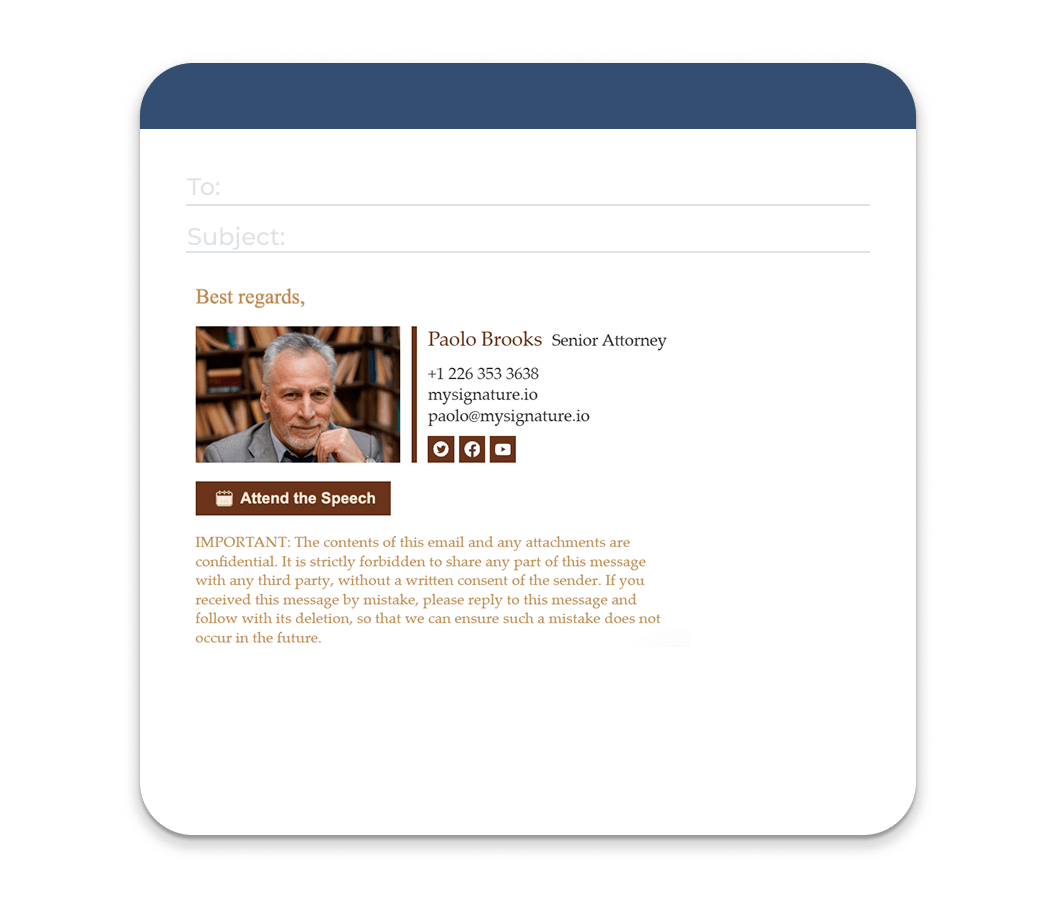
A disclaimer explains how the information in the message should be treated. It may state that the email contains confidential information, warn the recipient about possible virus transmission, or clarify that the opinions expressed belong solely to the author, not the company. Some also note that the email doesn’t create a contract or any form of legal commitment.
Do Email Disclaimers Have Legal Value?
While email disclaimers might sound formal enough to stop a lawsuit in its tracks, their legal value is limited.
Most courts don’t treat them as binding agreements. However, they act as supporting evidence—proof that your organization takes legal compliance seriously and makes a reasonable effort to handle private information responsibly in its email communications.
That means if an employee accidentally sends personal data to the wrong recipient, a clear email confidentiality notice won’t erase the mistake, but it can help demonstrate that your company took precautions. In some cases, that can reduce legal consequences or penalties.
Different regions have their own stance on disclaimers and data protection requirements:
- European Union (GDPR): Not a legal requirement, but a useful addition under the General Data Protection Regulation. Referencing your Privacy Policy in a disclaimer shows care in handling personal information.
- United States (HIPAA): Common in healthcare. A HIPAA email disclaimer can’t replace end-to-end encryption or secure storage, but it reinforces responsibility for protecting patient data.
- United Kingdom: Often used to reflect data protection and employer’s liability obligations, clarifying who holds responsibility in business communication.
- Canada and Australia: Anti-spam laws encourage adding unsubscribe options and sender identification to outgoing emails, making disclaimers part of compliance best practices.
In short, disclaimers won’t make you bulletproof in court, but they can prove that your business is mindful of privacy, risk, and responsibility. That alone can make a difference when legal teams start asking tough questions.
💡 Tip: Learn more about the legal impact of email signatures in our guide.
When Do You Need an Email Disclaimer?
Since Email disclaimers don’t guarantee legal protection, the real question is: when are they necessary—and when are they simply smart business?
In some cases, a disclaimer email signature is required by regional legal or regulatory requirements to include a compliant disclaimer that meets industry standards. For instance:
- Confidential or sensitive content: If your email includes client data, financial details, or personal identifiers, add a confidentiality disclaimer. It should warn that the information is for the intended recipient only and that any unauthorized review or use may carry legal consequences.
- Healthcare communication: For those handling medical or patient data, a HIPAA email disclaimer reinforces privacy obligations and signals adherence to confidentiality standards.
- Legal, financial, or government correspondence: These sectors rely on disclaimers to clarify that messages do not constitute binding agreements or legal advice.
- Marketing and bulk mail: Many anti-spam laws (in the EU, Canada, and Australia) require an unsubscribe link and sender details in outgoing emails.
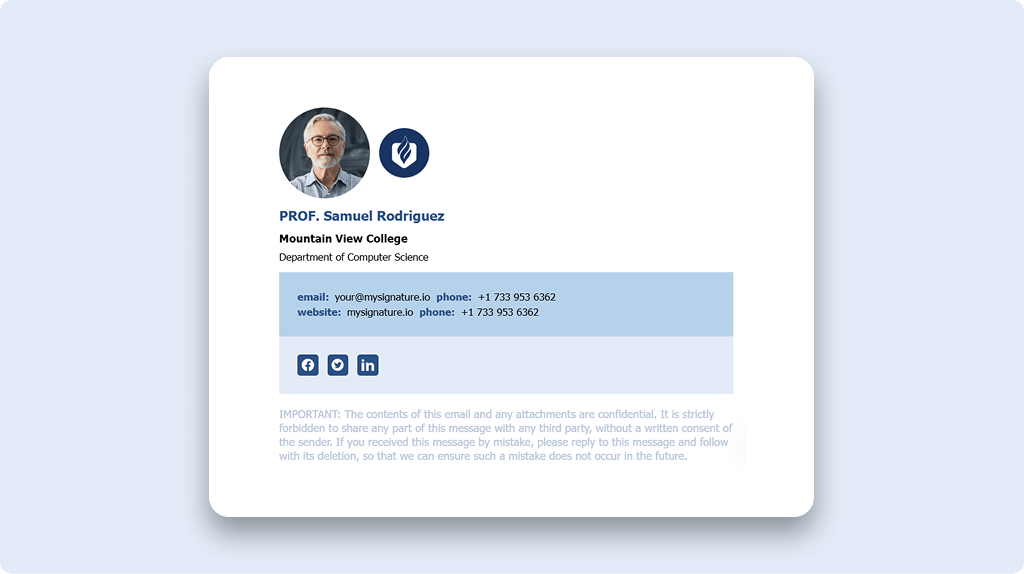
However, even when not mandated by law, adding a disclaimer can prevent confusion and protect your organization’s reputation. It’s worth including one when:
- Your team communicates externally with clients or vendors. It reinforces professionalism and outlines how information should be treated.
- You use shared or public email systems. External warning disclaimers (e.g., “This email originated outside the company”) help employees recognize potential phishing or spam attempts.
- You want to promote responsible communication. Adding an environmental message or non-binding statement can humanize your brand while clarifying intent.
- You’re unsure about local regulations. When compliance requirements differ between regions, a well-written, compliant disclaimer offers extra peace of mind.
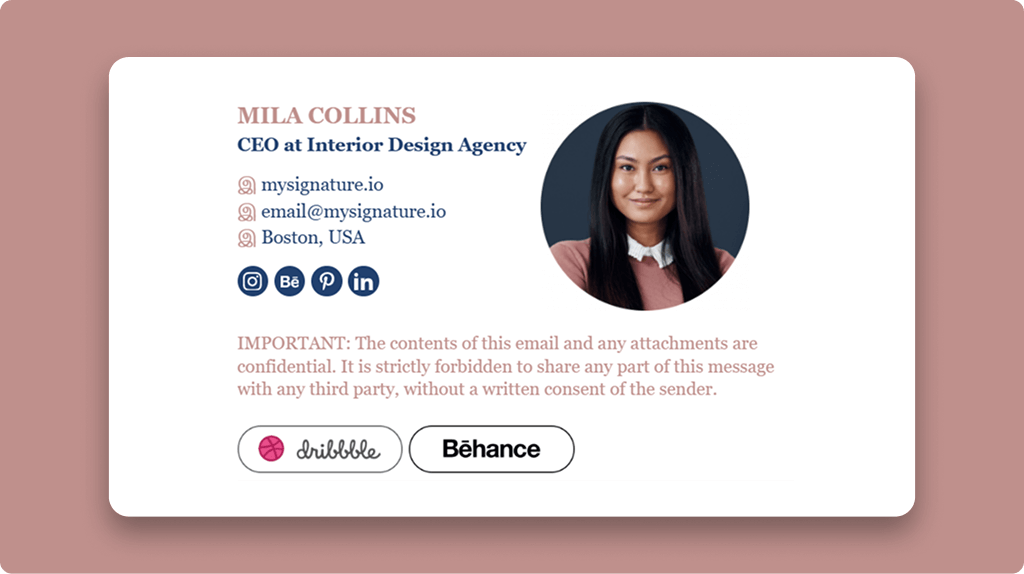
Key Elements of an Effective Email Disclaimer
Depending on the situation, the look and purpose of an email disclaimer will vary. Some focus on confidentiality, others on compliance or liability. But regardless of the disclaimer type, every effective disclaimer follows the same basic structure.
These are the key elements that make one clear, professional, and legally sound.
1. A Clear Statement of Purpose
Every email disclaimer should start with a short line that explains why it exists in the first place. For example, “This email and any attachments are confidential.”

The goal is to set the tone immediately and leave no doubt about how the message should be handled.
2. Identification of the Intended Recipient
Always specify that the content is meant for the intended recipient only. This protects the sender if an email is misdelivered and signals to unintended readers that they’re not authorized to use, forward, or copy the information.
3. Confidentiality and Privacy Notice
If the message contains private information, make that explicit. A concise confidentiality statement supports legal compliance and reinforces your organization’s commitment to data protection.
4. Liability and Contract Limitation
A strong disclaimer clarifies that the email doesn’t create a legal contract, formal commitment, or binding agreement. It may also limit responsibility for errors, computer virus transmission, or unintended consequences from relying on the message.
5. Regulatory and Company Details
If your region enforces legal or regulatory requirements, include the necessary company identifiers:
- Registered name
- Company address
- Legal entity number
This ensures your disclaimer qualifies as a compliant disclaimer and meets corporate disclosure obligations.
6. Security and Virus Warning
Include a short note encouraging recipients to scan attachments or links using virus detection tools. It’s a simple step that reduces security risks and shows your organization takes responsibility for the safety of its outgoing emails.
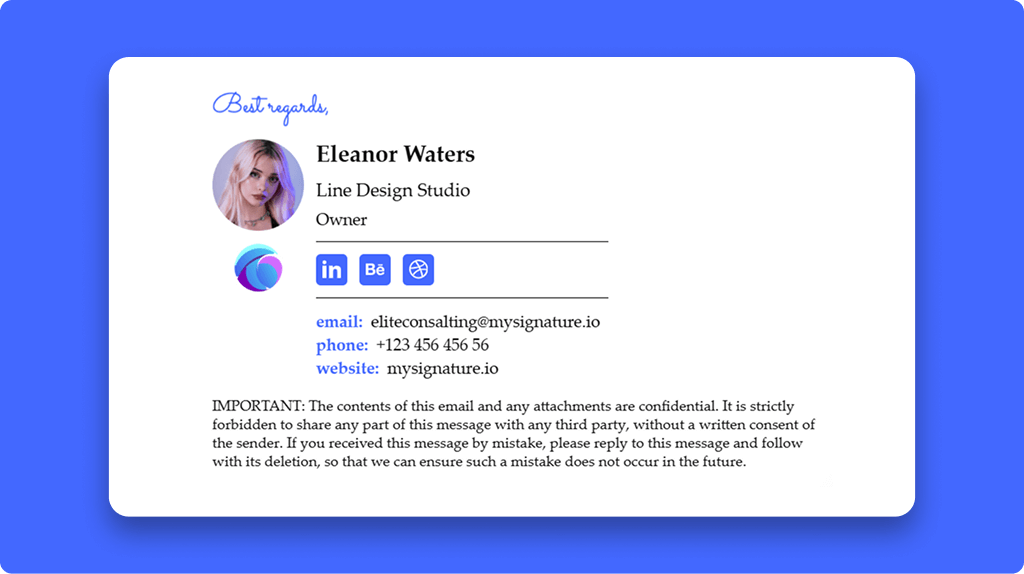
7. Contact or Correction Instruction
If someone receives the email in error, include a simple instruction to notify the sender and delete it. This shows care and helps limit potential data exposure.
8. Tone and Readability
Keep it short, clear, and easy to scan. A compliant disclaimer doesn’t need to sound like a legal textbook—plain language is more effective and more likely to be read.
💡 Tip: For more information regarding the best practices in email signatures (including disclaimers), check out our article!
Email Disclaimer Examples and Templates
While every disclaimer should follow the structure and best practices covered above, different types of disclaimers serve different purposes. Each focuses on a particular kind of protection—confidentiality, liability, compliance, or even sustainability. The right choice depends on the context of your e-mail message and your industry’s requirements.
Let’s look at the most common types of disclaimers used in professional communication, along with examples and disclaimer templates you can adapt for your corporate email signature.
Email Confidentiality Notice Disclaimer
A confidentiality disclaimer is one of the most common types, designed to protect sensitive information and restrict unauthorized sharing. It’s essential when your emails contain private or proprietary data—client details, internal documents, or financial information.
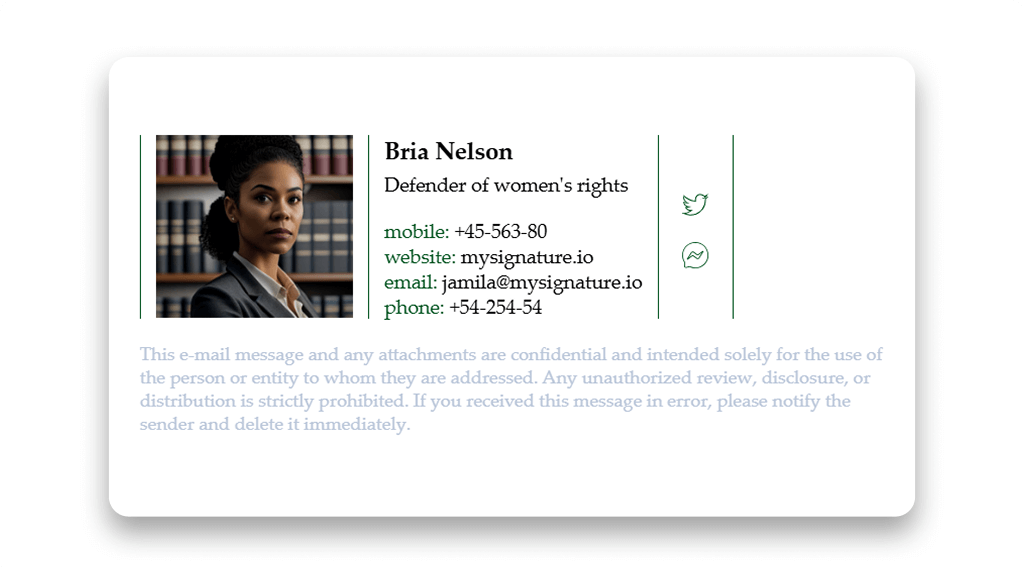
Confidential email disclaimer example:
This e-mail message and any attachments are confidential and intended solely for the use of the person or entity to whom they are addressed. Any unauthorized review, disclosure, or distribution is strictly prohibited. If you received this message in error, please notify the sender and delete it immediately.
Here are a few email confidentiality notice examples you can borrow for your email communications:
- This e-mail may include confidential information meant only for the intended recipient. If you are not that person, please do not read, copy, or share it. Notify the sender and delete the message immediately.
- We respect your privacy. This e-mail is intended for the named recipient and may contain private information. If it reached you by mistake, please let us know and remove it from your inbox. Thanks for your understanding.
Liability Disclaimer
A liability disclaimer limits your company’s exposure in case of errors, omissions, or unintended consequences resulting from your communication. It’s especially important for organizations offering professional advice—consultants, lawyers, accountants, or engineers.
💡 Tip: The liability email disclaimer may also cover Negligent Misstatement, clarifying that opinions expressed shouldn’t be relied upon as formal advice.
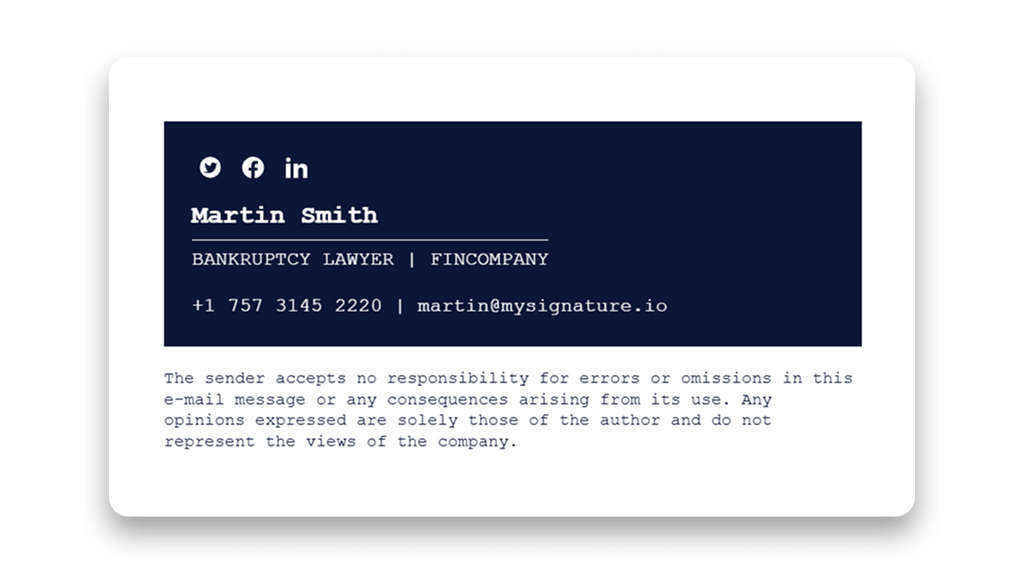
Liability disclaimer example:
The sender accepts no responsibility for errors or omissions in this e-mail message or any consequences arising from its use. Any opinions expressed are solely those of the author and do not represent the views of the company.
Here’s a selection of liability disclaimer templates for different use cases:
- The information contained in this e-mail is believed to be accurate but is not guaranteed. The company accepts no responsibility for losses arising from its use.
- Views expressed in this e-mail are those of the sender and may not reflect those of [Company Name]. No liability will be accepted for damages caused by reliance on this message.
GDPR Disclaimer
A GDPR disclaimer signals compliance with the General Data Protection Regulation, helping organizations demonstrate transparency when handling personal or sensitive data belonging to individuals in the European Union or EEA.
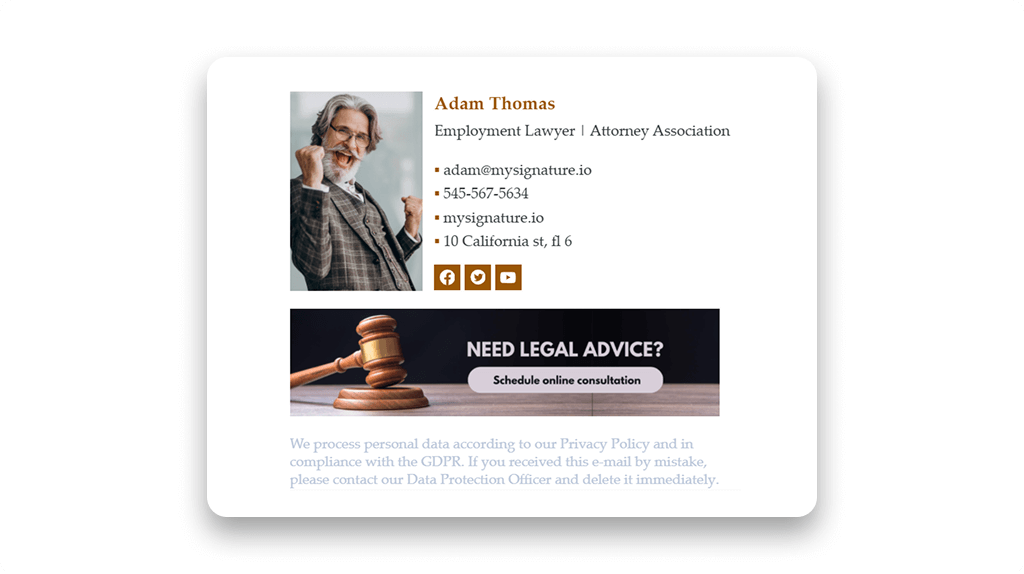
GDPR email disclaimer example:
We process personal data according to our Privacy Policy and in compliance with the GDPR. If you received this e-mail by mistake, please contact our Data Protection Officer and delete it immediately.
Check out the following GDPR disclaimer templates you can customize:
- [Company Name] processes personal information in accordance with the GDPR and our Privacy Policy, available at [link]. If you received this message in error, please delete it and notify us at [email].
- All personal data processed by [Company Name] comply with GDPR standards. Questions about your rights can be directed to our Data Protection Officer at [email].
HIPAA Email Disclaimer
If you’re dealing with protected health information (PHI) as a healthcare provider, insurer, or their partner, you need a HIPAA email disclaimer. It confirms confidentiality and clarifies the protocol if an email is received by mistake.
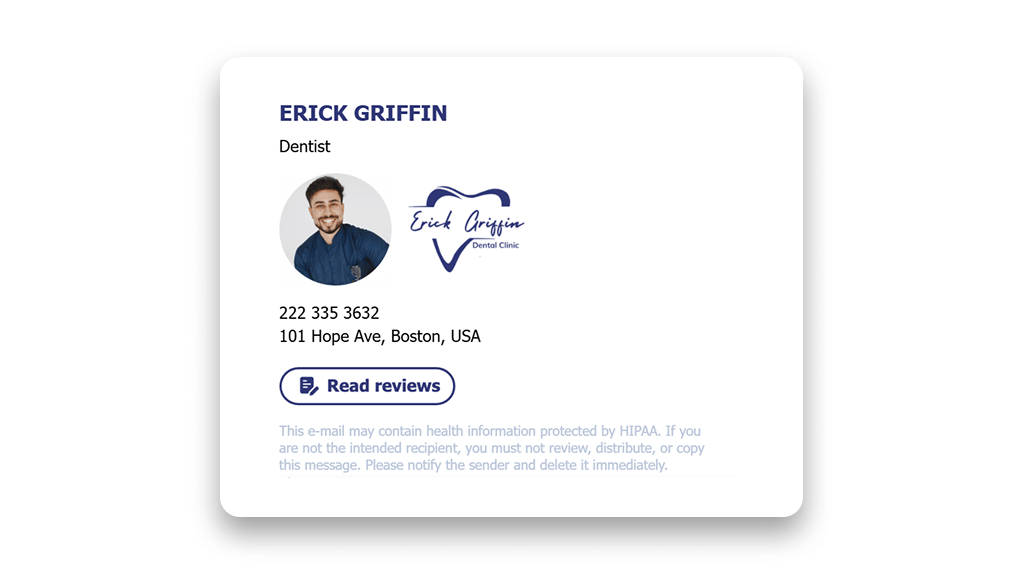
HIPAA email disclaimer example:
This e-mail may contain health information protected by HIPAA. If you are not the intended recipient, you must not review, distribute, or copy this message. Please notify the sender and delete it immediately.
If your business communication requires a HIPAA disclaimer, consider using one of the following templates:
- This message may contain HIPAA-protected information. If it’s not meant for you, please delete it and report the error to the sender.
- This message is for authorized recipients only and may contain protected health information (PHI). If you received it in error, contact our Compliance Office at [email] and delete all copies. We appreciate your help in protecting patient privacy.
Newsletter Disclaimer
A newsletter disclaimer helps comply with anti-spam laws and ensures transparency in marketing emails. It informs readers why they’re receiving the e-mail message and provides a clear unsubscribe option.
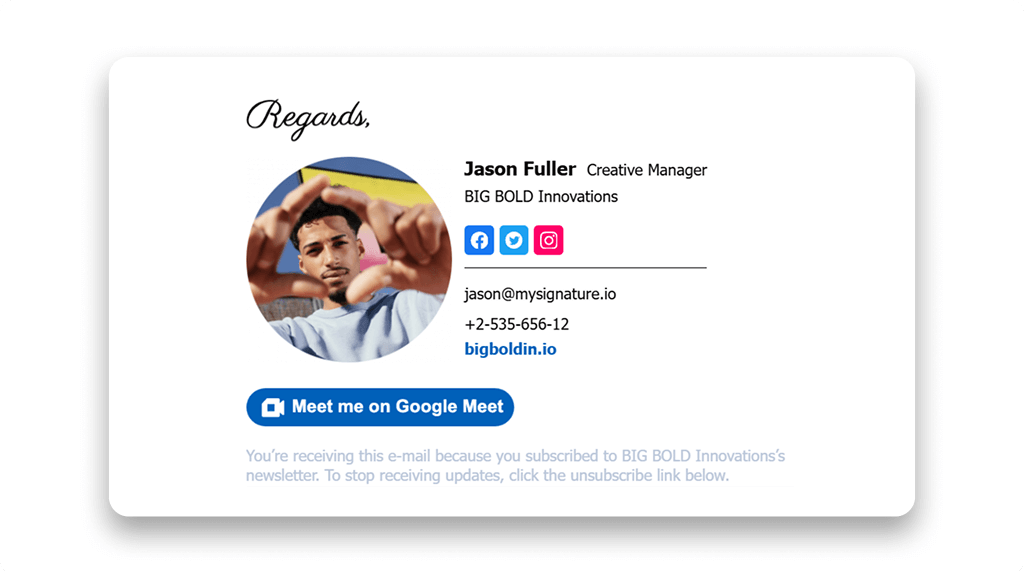
For example:
You’re receiving this e-mail because you subscribed to [Company Name]’s newsletter. To stop receiving updates, click the unsubscribe link below.
Some of the most common spread variations of the newsletter disclaimer template include:
- You received this e-mail because you joined our mailing list. To unsubscribe, click here [link].
- This message complies with global anti-spam laws. You’re receiving it because you opted in to [Company Name] communications. To opt out, use the unsubscribe link provided.
Environmental Disclaimer
Finally, an environmental disclaimer encourages eco-friendly behavior and shows your organization’s sustainability values. While it doesn’t serve a legal purpose, it adds a human, responsible touch to your corporate email signature.
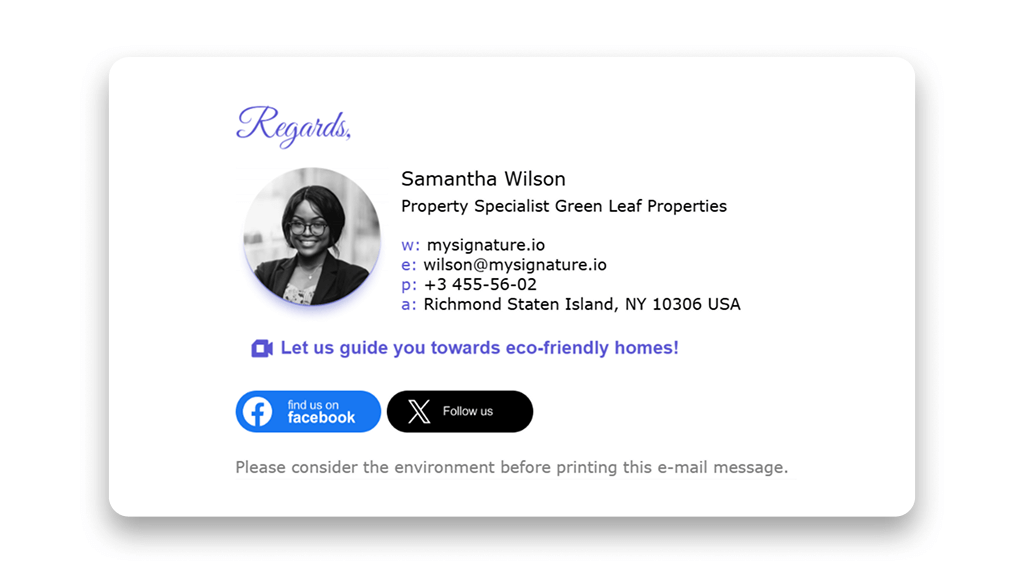
For instance, an environmental disclaimer can be short and sweet, like:
Please consider the environment before printing this e-mail message.
Here are several more environmental disclaimer templates:
- [Company Name] is committed to sustainability. Please avoid printing this e-mail unless absolutely necessary.
- This e-mail was sent electronically to save resources. Join us in supporting environmentally conscious communication.
How to Add a Disclaimer to an Email
Once you’ve written a compliant disclaimer, the next step is ensuring it appears consistently in your outgoing emails. There are several ways to do it—some more reliable than others.
1. Add It Manually
The most basic option is to type or paste the disclaimer at the end of every message. It works, but it’s unreliable.
Drawbacks:
- Easy to forget in replies or mobile emails
- Inconsistent formatting
- Higher chance of typos or missing legal text
- Wastes time on repetitive edits
Manual addition might be fine for occasional senders but won’t scale across a business.
2. Add It to a Text-Based Signature
A better approach is to include the disclaimer in your standard signature in the email sender.
It’s consistent and simple, but still limited:
- No visual branding or social media links
- Formatting may break across devices
- Doesn’t integrate smoothly with systems like Office 365 service
It’s a step forward, but not ideal for organizations that value design and compliance.
3. Use an HTML Email Signature
The most professional way to include your disclaimer is to create an email signature that embeds it directly into an HTML email signature using an email signature management tool like MySignature.
With MySignature, your disclaimer, contact details, and branding appear together in one visually consistent layout built with clean HTML code.

Advantages:
- Works perfectly across all devices and email platforms
- Automatically adds your disclaimer
- Keeps design consistent across teams
- Supports clickable logos, banners, and social media links
- Easy integration when setting up rules in Outlook
Final Thoughts
Email disclaimers protect sensitive information, support compliance, and maintain a professional image in every message you send. The best results come from keeping them clear, consistent, and automatically applied across your organization.
Ready to streamline your communication? Create a professional email signature with MySignature to ensure every email looks polished, compliant, and on-brand.

FAQs About Email Disclaimers
What should an email disclaimer include?
An effective email disclaimer should state the message’s purpose, identify the intended recipient, include a confidentiality or liability notice, and meet any regional compliance requirements.
Optional additions include company details, a privacy link, or an environmental note.
Is it a legal requirement to have an email disclaimer?
Not always. While some industries and regions mandate certain disclosures, most businesses use disclaimers as a best practice to limit risk and demonstrate compliance.
Can I use the same disclaimer for internal and external emails?
It’s better to tailor them. External emails often need confidentiality, liability, or compliance statements, while internal disclaimers can focus on privacy and proper data handling.
Where should the disclaimer be placed in an email?
Place it directly below your corporate email signature so it appears automatically in all outgoing messages without disrupting readability.
Can I write my own disclaimer or should I consult a lawyer?
You can create one using trusted email disclaimer templates, but if your emails contain sensitive data or fall under strict regulations, have a legal professional review it to ensure full compliance.


